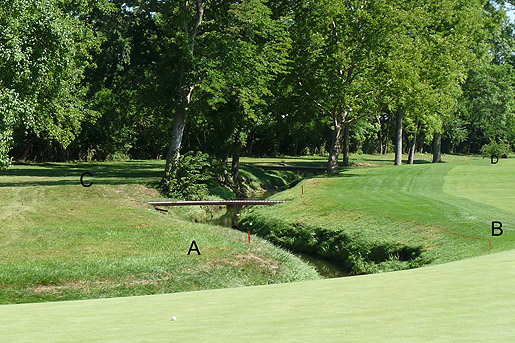 Toledo, Ohio – When golfers hit their shot into a
lateral water hazard (one marked by red stakes) most golfers know that one of
their options is to drop within two club-lengths of the point where the ball
last crossed the margin of the water hazard.
But Rule
26-1c provides another option to the player that can be even better.
Toledo, Ohio – When golfers hit their shot into a
lateral water hazard (one marked by red stakes) most golfers know that one of
their options is to drop within two club-lengths of the point where the ball
last crossed the margin of the water hazard.
But Rule
26-1c provides another option to the player that can be even better.
The second option is to find a point on the opposite margin of the hazard that is the same distance from the hole as the point where the ball last crossed the margin of the hazard and drop within two club-lengths of there.
In the picture of the 14th hole at Inverness Club to the left, if the player’s shot from point D last crossed the margin of the hazard at point A, the player has four choices for taking relief with a penalty stroke.
· The first one (26-1a) would be to return to where the ball last was played (point D).
· The second (26-1b) would be to go back on the extension of a line from the flagstick to point A and drop the ball (a straight line from A through point C), since this entire line is in the rough it isn’t necessarily desirable.
· Third, 26-1c would allow the player to drop within two club-lengths of point A no nearer the hole. Again, this is in the rough.
· The final option that is frequently forgotten would be to find the point, B in this case, that is the same distance from the hole and on the opposite margin of the hazard as A and drop within two club-lengths of that point, not nearer the hole. This may allow the player to get into the fairway.
There may even be another opposite margin to the left of A that might even allow the player to drop on the putting green.
In determining points on the opposite margin, the straight line from A to B must always stay inside the hazard. If the line from the point of entry to the point on another margin crosses any area that is not inside the hazard, that margin cannot be used. See Decision 26-1/14 for a graphic example of this principle.
If this hazard were marked with yellow stakes or lines, the only options would be dropping at point D or along the line from A to C.
Written by John Van der Borght, manager of Rules Communications for the USGA.
